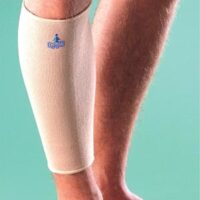Tibial Stress Fracture

Article by Matthew Hewitt

Tibial Stress Fracture
What is a Tibial Stress Fracture?
A Tibial Stress Fracture is an overuse injury affecting the shin bone, commonly occurring due to repetitive stress beyond what the bone can withstand. It often arises in athletes or individuals who increase their activity levels too quickly, particularly in sports like running. This injury is closely linked to inadequate muscle strength and poor biomechanics, which leads to excess strain on the bone.
Read more: Shin Pain Relief | Stress Fracture Diagnosis
Why Do Tibial Stress Fractures Occur?
Tibial stress fractures are caused by overloading the tibia. This often results from a combination of factors, including insufficient muscle support in the lower leg, poor foot posture, incorrect footwear, and overtraining. When muscles surrounding the tibia, like those in the ankle and foot, cannot absorb impact forces effectively, the bone absorbs them instead, leading to micro-fractures.
Read more: Causes of Shin Pain | Biomechanical Issues
How to Identify Tibial Stress Fracture Symptoms?
The symptoms of a tibial stress fracture gradually build over time. Early signs include pain during high-impact activities such as running or jumping. Without treatment, the pain can progress to constant discomfort during weight-bearing activities and may persist even at rest. Tenderness along the shin bone is also a common sign.
Read more: How to Manage Stress Fracture Pain
What Tests Diagnose Tibial Stress Fractures?
Diagnosing a tibial stress fracture typically involves an MRI scan or a bone scan. X-rays may confirm a significant fracture, while MRIs help in grading the injury, which ranges from periosteal oedema (Grade 1) to full cortical fractures (Grade 4). Sometimes, an ultrasound is used to assess tissue injuries, though it’s less effective for viewing the fracture itself.

Tibial Stress Fracture Treatment Phases
- Pain Relief and Protection: Initially, pain management is crucial. Avoiding weight-bearing activities helps to prevent further damage. Physiotherapists may use ice therapy, taping, and soft tissue massage to reduce inflammation.
- Restoring Range of Motion (ROM): As pain reduces, the focus shifts to improving ankle and foot joint mobility. Your physiotherapist will use stretching exercises, massage, and alignment techniques to restore normal function.
- Muscle Control and Strength: Once weight-bearing is resumed, strengthening exercises target weakened muscles, particularly foot arch-posture muscles. Restoring proper foot posture is essential for preventing recurrence.
- Returning to Full Function: Rehabilitation is personalised depending on whether the goal is walking, running, or a more strenuous activity.
- Prevention: Correcting biomechanics, assessing foot posture, and addressing footwear choices help reduce the risk of future tibial stress fractures.
Read more: Stages of Stress Fracture Rehabilitation | Foot Posture Correction Exercises
Latest Research on Tibial Stress Fractures
Recent studies show the importance of combining early diagnosis with tailored rehabilitation programs to ensure a faster recovery and reduced recurrence rates. Systematic reviews suggest that addressing biomechanical factors and implementing proper training techniques can significantly lower the risk of tibial stress fractures in athletes (Milner et al., 2023).
Read more: Overuse Injury Prevention
FAQs for Tibial Stress Fracture
- Why do tibial stress fractures occur?
- They result from overuse and inadequate muscle support, causing micro-damage to the tibia.
- How long does it take for a tibial stress fracture to heal?
- Recovery typically takes 6-8 weeks with appropriate rest and rehabilitation.
- What are the symptoms of a tibial stress fracture?
- Symptoms include shin pain, tenderness, and discomfort during activities like running.
- Can you walk with a tibial stress fracture?
- It’s advised to avoid weight-bearing until cleared by a healthcare professional.
- What causes shin pain while running?
- Common causes include overtraining, poor biomechanics, and inadequate footwear.
- How is a stress fracture diagnosed?
- Diagnosis often involves an MRI or bone scan to confirm the presence of a fracture.
- What is the difference between a stress fracture and shin splints?
- Shin splints cause muscle inflammation, while stress fractures are small cracks in the bone.
- What exercises help recover from a tibial stress fracture?
- Strengthening and stretching exercises aimed at foot posture and leg muscles assist recovery.
- Is surgery necessary for a tibial stress fracture?
- Surgery is rarely needed unless the fracture fails to heal with conservative treatment.
- How can you prevent tibial stress fractures?
- Proper training techniques, footwear, and addressing biomechanical issues help in prevention.
Read more: Diagnosing Lower Leg Pain
What to Do?
If you suspect a tibial stress fracture, seek professional advice from your physiotherapist or doctor. Early diagnosis and a structured rehabilitation plan will help you recover fully and prevent future injuries.
Rochedale - Call 38410277
Book Online: RochedaleSalisbury - Call 32751044
Book Online: SalisburySandgate - Call 32691122
Book Online: SandgatePosterior Shin Splints FAQs
1. What causes posterior shin splints? Posterior shin splints are caused by overuse of the tibialis posterior muscle, poor foot biomechanics, and training errors. These factors place stress on the shinbone, leading to pain and inflammation.
2. How are posterior shin splints diagnosed? Physiotherapists diagnose posterior shin splints through a physical examination, assessing pain location, and possibly using imaging tests like X-rays or MRIs.
3. Can you continue running with posterior shin splints? Continuing to run with posterior shin splints can worsen the condition. It’s important to consult with a physiotherapist for a modified training plan.
4. What is the best treatment for posterior shin splints? Effective treatment includes rest, ice, proper footwear, strengthening exercises, and possibly orthotics. Physiotherapists can provide a tailored treatment plan.
5. How long does it take for posterior shin splints to heal? Healing time varies but generally takes several weeks to months, depending on the severity and adherence to the treatment plan.
6. Are posterior shin splints the same as stress fractures? While related, posterior shin splints and stress fractures are different conditions. Posterior shin splints can lead to stress fractures if left untreated.
Related Articles
- Stress Fracture Treatment – Discusses how to recover from stress fractures with a physiotherapy approach.
- Shin Splints Explained – Explains the causes of shin splints and how they differ from stress fractures.
- Foot Posture Correction Program – Learn how correcting foot posture can prevent lower limb injuries.
- Running Injuries Prevention – Covers common running injuries and how to avoid them.
- Ankle Sprain Recovery – Guide to recovering from ankle sprains with physiotherapy.
- Foot Biomechanics and Injury Prevention – Explains how biomechanics affect injury risk.
- Plantar Fasciitis Relief – Learn about treatment options for plantar fasciitis.
- Achilles Tendinopathy – Detailed advice on managing Achilles tendon injuries.
- Lower Limb Injury Rehabilitation – Rehabilitation techniques for lower limb injuries.
- Sports Injury Prevention – Tips on preventing sports injuries through proper training techniques.
- Tibial Stress Fracture in Athletes – A detailed guide on tibial stress fractures and recovery for athletes.
- Stress Fracture Management – Covers causes and management strategies for stress fractures.
- Preventing Running Injuries – Explains how to prevent injuries like tibial stress fractures through proper running technique.



















































